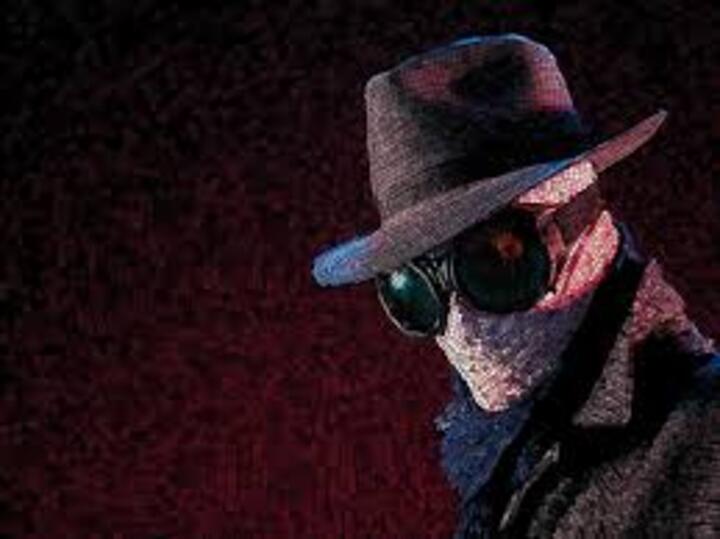
Imagine a world where you could throw on a sweater and vanish from the watchful eye of AI security cameras. Researchers at the University of Maryland are making science fiction a reality with their development of an “invisibility cloak” that confuses artificial intelligence.
This isn’t your typical Hollywood invisibility cloak. The Maryland team’s creation is a specially designed garment patterned with intricate designs that exploit vulnerabilities in how AI object recognition systems work. These patterns, known as adversarial examples, confuse the AI’s ability to distinguish between the wearer and the background.Excited, lets know in details what ai invisibility cloak is actually is.
What is the AI invisibility cloak all about
The project, led by Professor Tom Goldstein, represents a significant step forward in the field of adversarial machine learning. Adversarial machine learning focuses on finding weaknesses in AI systems and exploiting them. In this case, the researchers are using this knowledge to develop methods for bypassing AI object detection.
The University of Maryland’s invisibility cloak isn’t perfect. Current iterations only work against specific AI systems and can be bulky and visually unappealing. However, the project holds immense promise for the future.
How AI invisibility cloak actually works
University of Maryland of an unseen shroud from a point of AI, the future looks so interesting. There are difficulties, but the investigation opens the road for cutting-edge models and brings out engaging conversations around the ethical creation and application of AI technology.
A document describes the “invisibility” cloak that you can wear and it will prevent detectors to discover the wearer. Its action is determined by the technique, which is called the adversarial patterns and with it the detection score is suppressed. Among the most frequently used detectors there has been found the one. These patterns are obtained by training a model on a set of images and then utilizing the gradient descent algorithm to direct the model to a lower error region on the objectness scores space for each category.
Patterns of resistance in a kind of algorithms that are specially tailored to deceive detectors. These detectors are not only able to distinguish but also being able to place these objects within their respective images and videos.
They usually operate by comparing an image with many possible candidates for bounding boxes, i.e. rectangular portions which are assumed to contain an object. For every bounding box, it assigns a score of objectness which shows how confident the detector is about object being inside the particular bounding box. A high reading of objectness is equivalent to a high degree of certainty, while a low reading can be taken to be a low degree of certainty.
The ‘university of Maryland’ invisibility cloaked model uses adversary patterns to deceive these objectness values. In our application, the cloak’s design pattern is perfectly aligned with the target algorithms so the low objectness scores can spread constantly to the whole image. At the end the labels confuse the detector and thus, instead of detecting anything within a particular bounding box, the detector becomes unsure whether a person is wearing a cloak or not.
By strategically reducing objectness scores across the entire image, the cloak effectively tricks the detector into believing that there is nothing to see. This is how the cloak achieves its invisibility effect, at least in the context of fooling certain object detection systems.
Materials and Technology Behind the Invisibility Cloak
Algorithm based
– The operation is to make patterns that make the neural networks of computer vision to not detect the person or object.
– Researchers demonstrate a pattern recognition that has been constructed for the purpose of a futile identification by modern object detectors like YOLOv2.
– This pattern is trained using machine learning algorithms based on the large data sets such as Mico, having a diversity of photographs of people and objects.
– The purpose is to design a “ghost cloak” that makes the wearer supportless and unseen to AI-assisted surveillance systems².
Metamaterial-Based Cloaking
– The metamaterials are created with the properties and characteristics which do not exist in the naturally occurring substances and they have the ability to interact with the electromagnetic waves differently.
– A small cloak that manipulates light waves surrounding an object hides it from view because of a specified wavelength band has been developed by the University of Maryland team.
– The cloak consists of concentric gold rings placed on a polymethyl methacrylate substrate, under which a gold surface descends.
– By altering the conductance of the light-metal mixture, the scientists produce plasmons, which are waves of electrons developed when light hits the metal screen. This becomes invisible to the human eye on the technical level.
– It is still in the developing stages and two dimensional light in a limited band width at the moment. The next step that is to go deeper into the dimensions and range is the main challenge that the researchers try to solve on the go.
These advancements in cloaking technology could have various applications, from enhancing personal privacy to creating more effective stealth technology for military use.
The research is ongoing, and while practical, everyday invisibility cloaks may still be a thing of the future, these developments represent exciting progress in the field.
Applications of AI Invisibility CloakTechnology
Metamaterials University of Maryland representatives and their “AI Invisibility cloak” though still in its infancy hint at some extent as to how in the future the AI will be able to change the way the AI perceives the world.
This technology has the potential to revolutionize various fields, bringing both benefits and challenges:Thus, there develops the field of the technological revolution that a question is about to come out.
Privacy Protection:
• Shielding from Surveillance: Think about how would that be to be at a place, a place where AI-oriented security cameras are there but you sneak to their unobservable part. This is a tool that leads to the situation where the degrees power of control of individuals over their privacy levels in the dense urban dwellings has significantly increased.
• Augmented Reality Filters: The techniques of ‘invisibility effect’ will probably the ones which include these patterns in the AR filters, thus allowing users to change or modify their appearance as they desire.
Military and Law Enforcement:
• Camouflage for Soldiers: The decision about the modes of employment of these soldiers will depend on the context, and they can be on the missions where AI-operated enemy surveillance systems will be confused with different camouflaging technologies.
• Covert Operations: Under the guise of covertness, human security workers can effectively prevent their AI cameras from being able to track them quickly, which provides them with temporary inaccessibility to power.
Entertainment and Interactive Media:
• Interactive AR Experiences: Consider a situation from when, instead of the regular classrooms, the students are able to attend the lessons dressed in the concealing garment that allows them to camouflage in the universally recognized initiation environment for the game.
• Magic Show Illusions: There are no limits to your imagination if you learn how to create a coherent illusory pattern starting with the Impossible Square Pattern to Hexillogramic Art Pattern. Such remarkable designs would leave audiences confused as to who’s wearing the costume.
Ethical Concerns and Considerations:
• Criminal Misuse: The impunity which criminals are guaranteed by the covering of the net is the most influential one. Terrorists don’t need to worry about the law anymore as they are even less likely to be prosecuted for their offenses.
• AI Arms Race: This research may result into an escalation of a war between AI developers who want to develop new methods of detection sensor technology and a rapid growth of the adversarial machine learning research that introduce new undetectable objects or tactics. By ratifying this treaty, it could be seen to be just a vain attempt on your part and not others.
• Bias and Discrimination: The detection techniques bearing the name of adversarial invisibility could directly contribute to the existing system biases in the AI systems. For example, a jacket explores slippages inherent in the facial recognition algorithm taught to identify particular demographic group may introduce a bias and exclusion.
Challenges and lititations
The AI cloak that University of Maryland has developed has evoked the creative imagination, and it gladdens the heart to see that AI too can be manipulated to act according vision of the world. However, this groundbreaking technology comes with a set of challenges and considerations that require careful attention:However, this groundbreaking technology comes with a set of challenges and considerations that require careful attention:
Limited Scope:
• AI Specificity: Although the present version of the cloak actionable only against a certain kind of AI, detection algorithms the present version is in progress. Changing and adopting it to obtain AI that range is one of a major problems.
• Detectability: A cloak can blend in completely and might theoretically be undetectable. But the object recognition AI might allow for the identification of indicators of an adversarial pattern, so the cloak may soon become a relic of the past.
Ethical Concerns:
• Misuse for Malicious Intent: One of the big security issues that could be exploited by the criminals is the distorted footage. It could be used for purposes like hiding from the security camera or getting away from the facial recognition. The risk of a catastrophe from this source should be moderated via rules and development procedures that are responsible for it.
• Privacy vs. Security: It’s no surprise that there’s an urge for personal privacy while in the digital age. While the blankets may assist illegitimate attempts at interference and abridging public safety, they could also likely obstruct law enforcement attempts and thus creating a complex dilemma between privacy and public safety.
Unforeseen Consequences:
• AI Arms Race: This research could stimulate the ‘arms race’ to where the two spheres perpetually strive to enhance their detection systems, the researchers in the adversarial research advancing their cloaking methods. This turn could imply unforeseen problems as both sides will strive to secure the last word in their disputes.
• Bias Amplification: Different methods of evil invisibility can be guided by the already existing biases embedded into the AI substance. As another illustration, a hood which is customer of a facial recognition system oppressing certain demographic could lead to some ethical not easy hurdles.
Unequal Access and Societal Impact:Unequal Access and Societal Impact:
• Accessibility Gap: If the cloak is marketed for sales, without doubt it is going to be a sophisticated equipment, which the majority ended-up can’t afford, resulting for having monetary gaps even larger between the people with money and those without.
• Impact on Vulnerable Groups: The hat could dodge law enforcement presentations in this way. Thus, the hoodie could favor the people who are already less privileged and eventually the work to help track down the missing people, or protect the vulnerable populations will become harder.
As digital marketers, we understand that we have tremendous power to influence customer behavior through personalization technology and targeted advertising. However, just as digital advancements can benefit consumers, they can also be misused by malicious actors
Conclusion
These examples show the way of development of a mechanism to safe such wrong usage. The dialog between researchers, policy makers and public has to be considered the most important part during these technologies utilisation mitigating ethics issues.
By recognising the concerns and actively finding solutions, we can avoid the AI invisibility cloak turning into a tool for harm but a pillar that provides a base for these pondering questions on privacy, security, and responsible development of AI in the near future.
